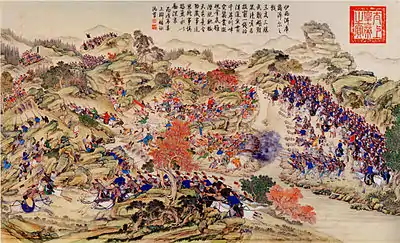| Battle of Yesil Kol Nor | |||||||
|---|---|---|---|---|---|---|---|
| Part of the Ten Great Campaigns | |||||||
 | |||||||
| |||||||
| Belligerents | |||||||
| Qing dynasty | Khwāja-i Jahān and Burhān al-Dīn | ||||||
| Commanders and leaders | |||||||
|
Fu De Arigun |
Khwāja-i Jahān Burhān al-Dīn | ||||||
| Strength | |||||||
|
10,000 infantry 10 zamburaks 20 cannons | 10,000 infantry | ||||||
| Casualties and losses | |||||||
| 400 |
2,000 surrendered many dead and wounded | ||||||
The Battle of Yesil Kol Nor (Chinese: 伊西洱庫爾淖爾之戰) is an 18th-century war painting created by Chinese court painters and European Jesuits. It was commissioned by the Qianlong Emperor of the Chinese Qing dynasty as part of an order of 16 large battle paintings (8 metres wide by 4 metres tall) to commemorate battles that took place in Qurman, in modern-day Tajikistan in February 1759. The battles resulted in the Qing Empire successfully regaining control of Xinjiang from the Turks who had occupied the province following the ousting of the Dzungar people from the region by Qing forces.[1]

The plinth of Chinese Monument set by the Lake Yashilkul, photoed by the Russian in the 19th century.
References
This article is issued from Wikipedia. The text is licensed under Creative Commons - Attribution - Sharealike. Additional terms may apply for the media files.